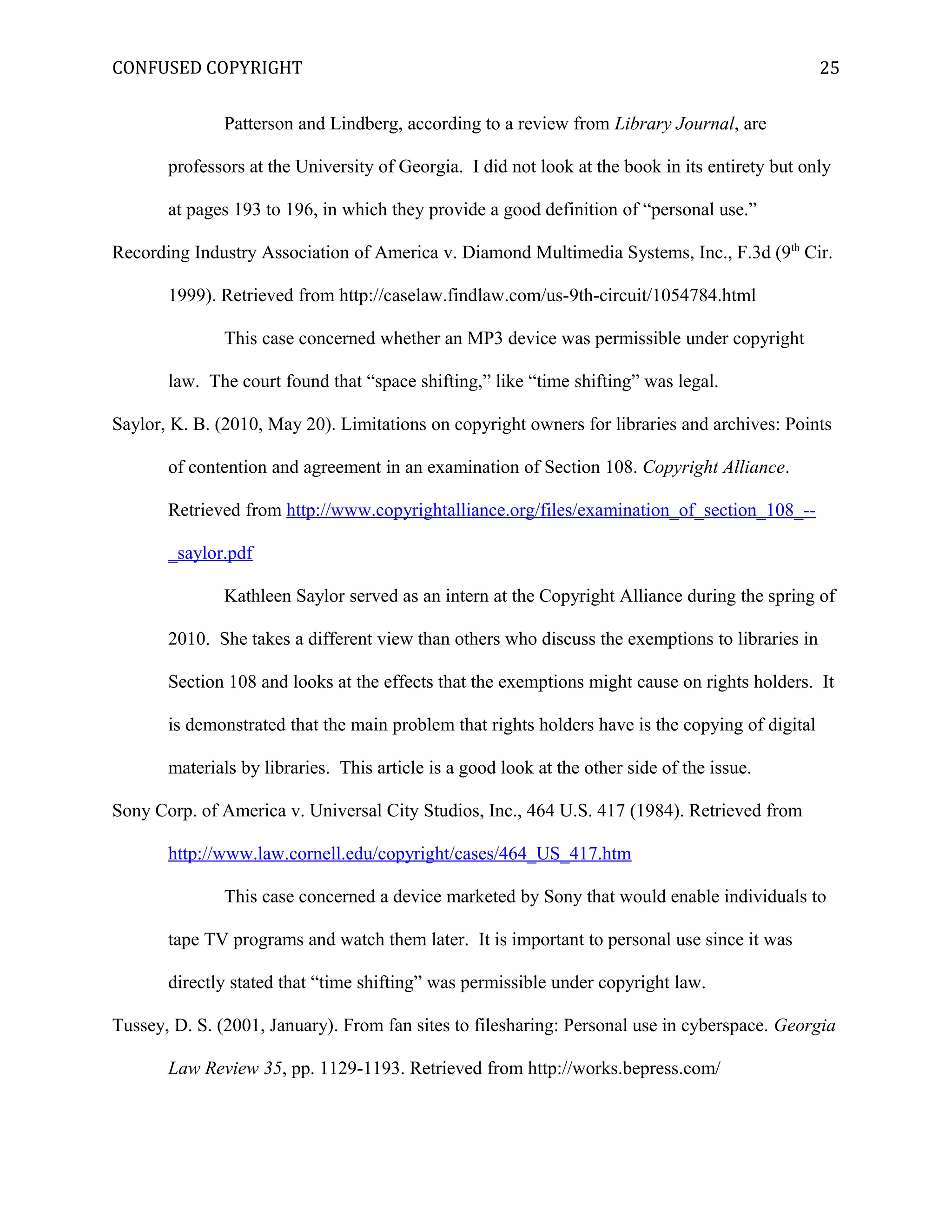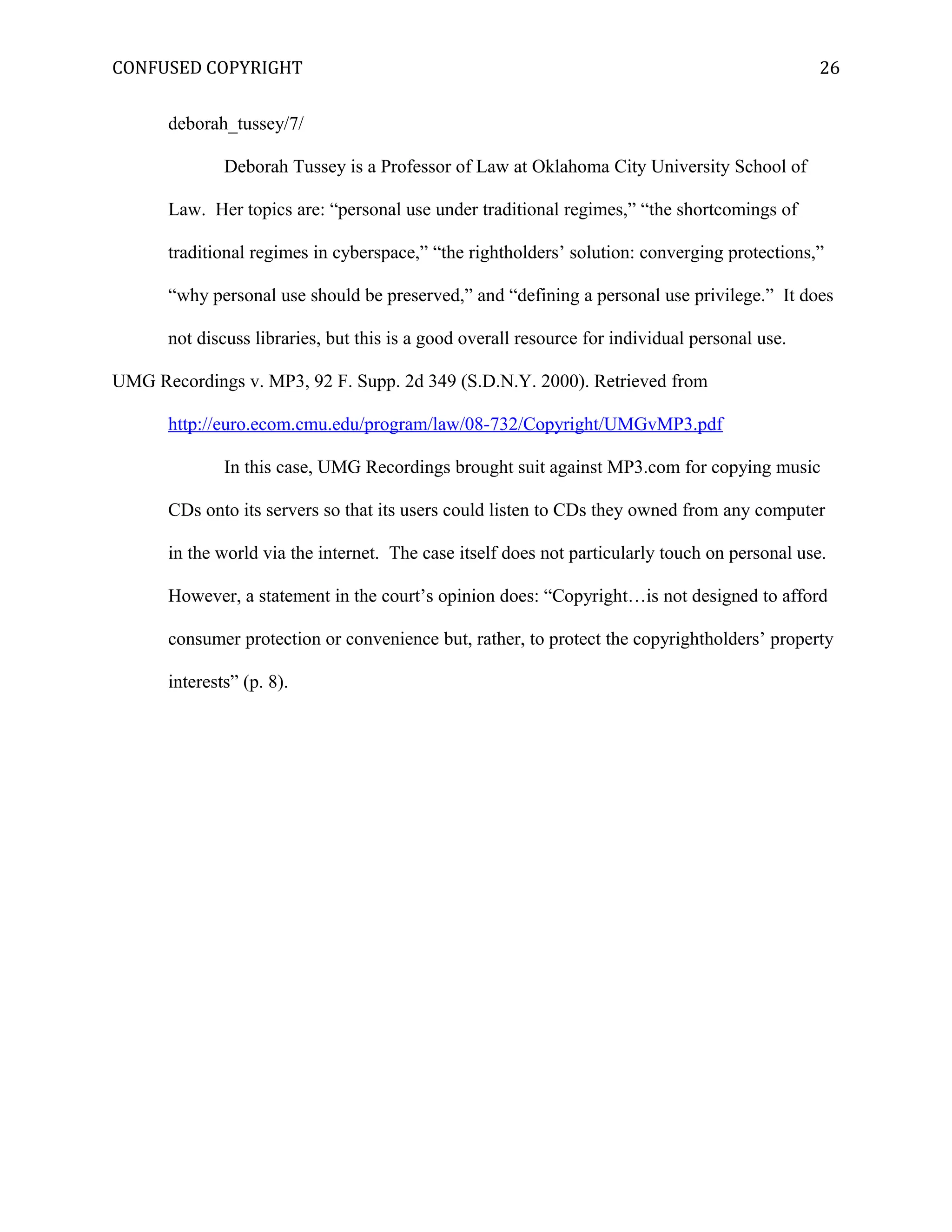The document discusses the complexities and controversies surrounding personal use of copyrighted works, highlighting the misunderstandings between users, copyright holders, and libraries. It argues that libraries play a crucial role in navigating copyright laws, as they often represent the interests of the public in the personal use debate. Additionally, it emphasizes the need for clear definitions and guidelines regarding personal use, which remains ambiguous and contentious in the face of evolving technology and legal interpretations.
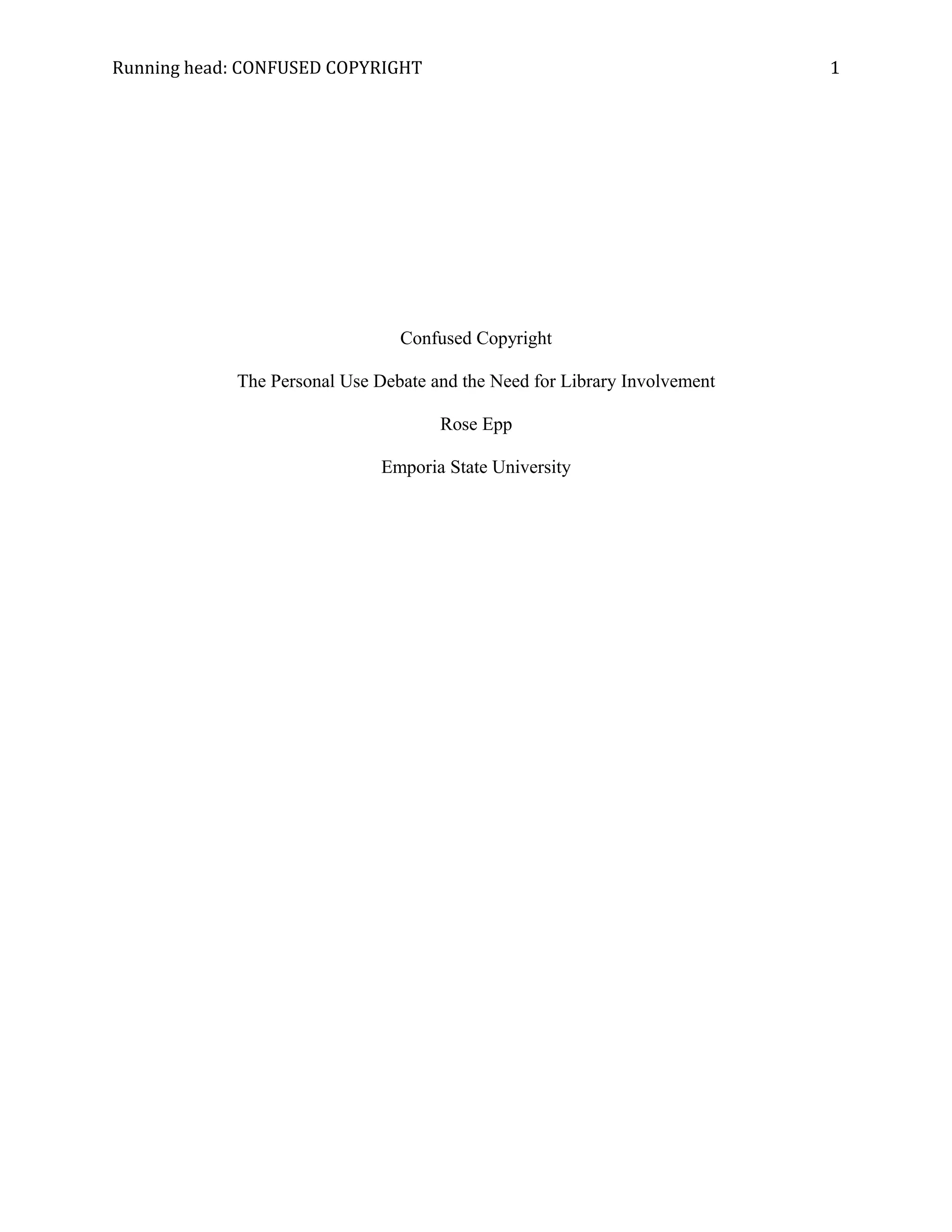
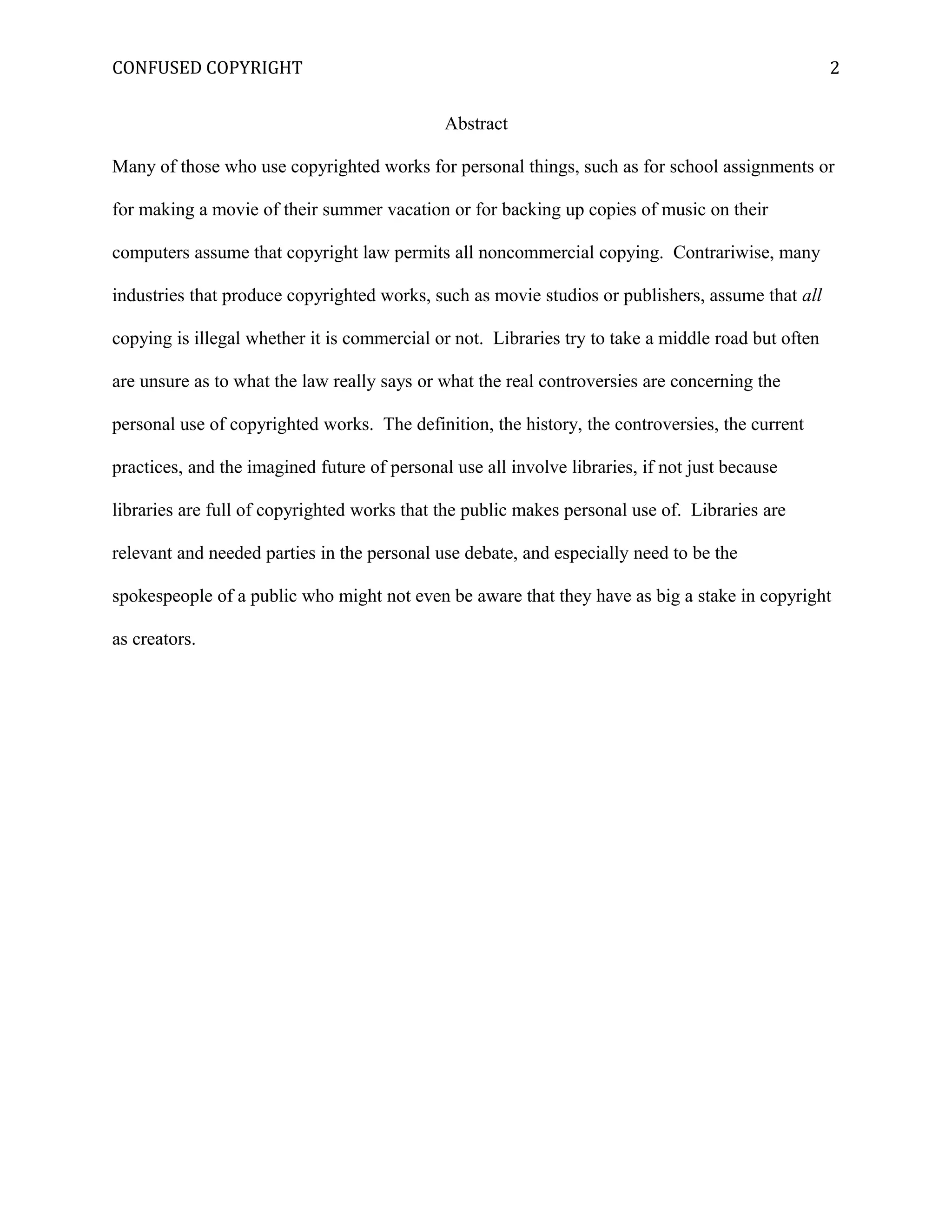
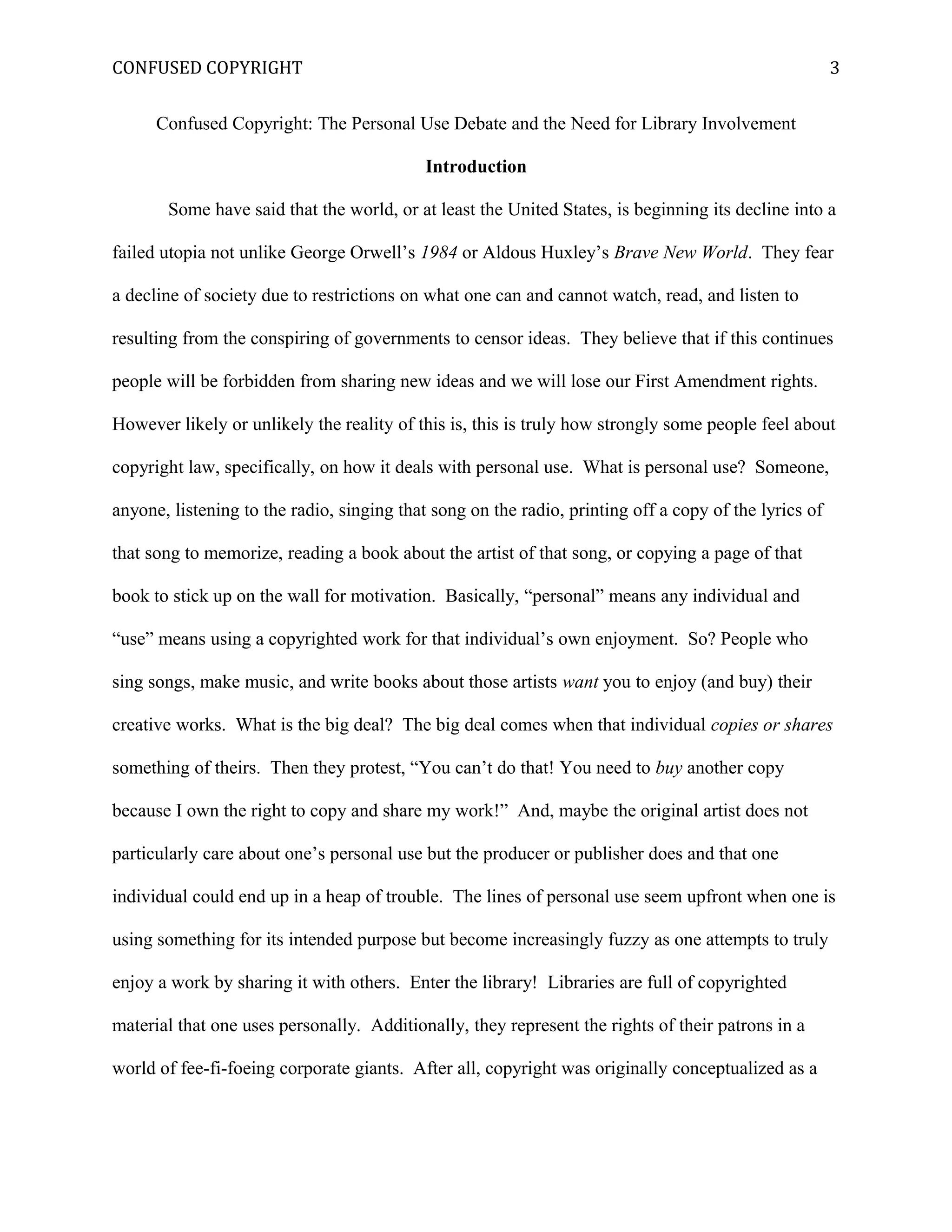
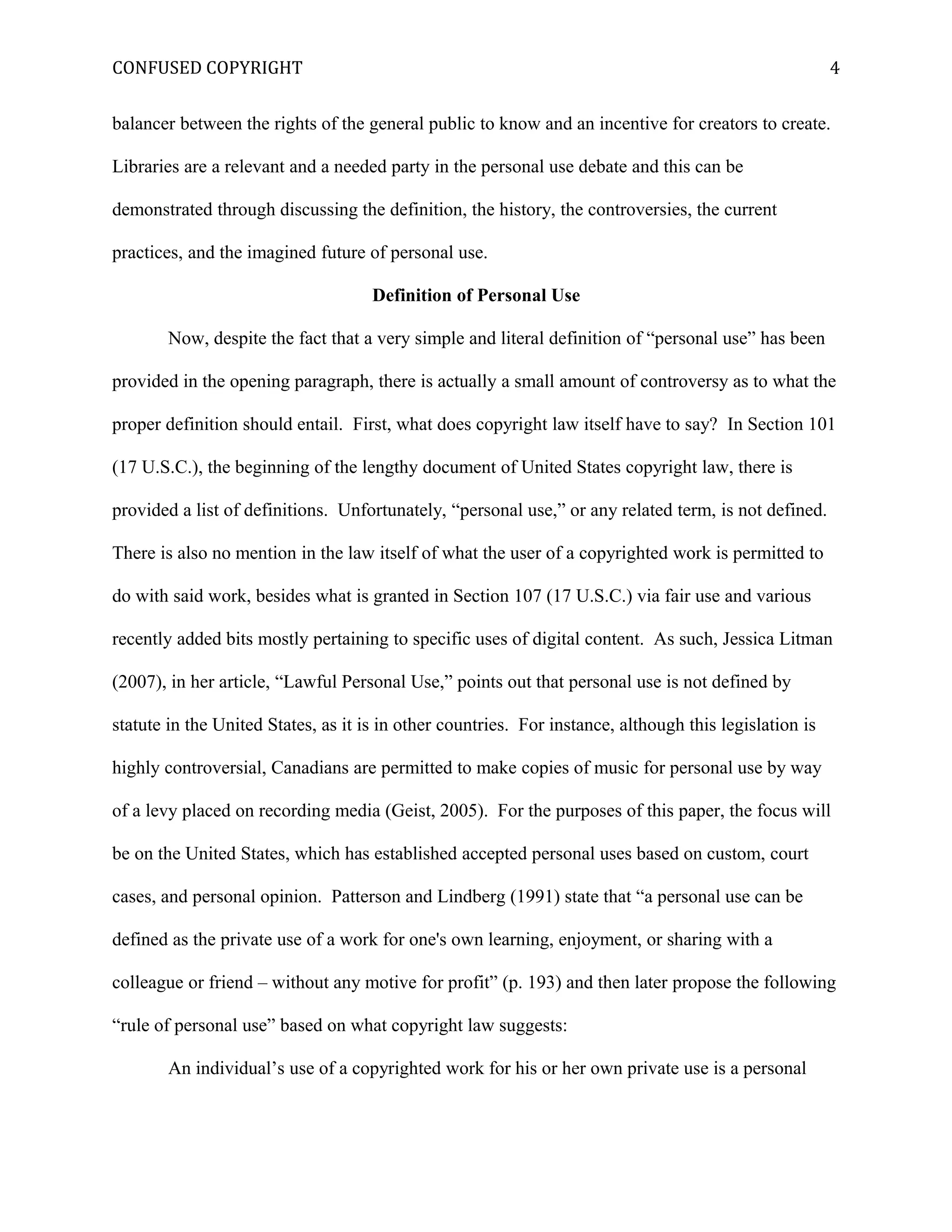
![CONFUSED COPYRIGHT
use, not subject to fair-use restraints. Such use includes use by copying, provided that
the copy is neither for public distribution or sale to others nor a functional substitute
for a copyrighted work currently available on the market at a reasonable price. (p. 194)
Litman (2007) defines personal use as “a use that an individual makes for herself, her family,
or her close friends” (p. 1894) while also assuming that some personal uses will be unlawful
and some will be controversial. The owner of a website containing music states, “Personal
private use is that which occurs within you [sic] immediate biological family” (Jordan, 2000).
Deborah Tussey (2001) gives her definition as: “‘Personal use,’ in the broad sense, means
consumption or adaptation of intellectual properties by individual users for their own
purposes, including uncompensated sharing of those works with others.” Since the law has
not defined “personal use,” it is important for a library to know all sides of this issue so that
they will either be ready to suggest reliable sources to any patrons who have questions about
copyright or to engage in a copyright education campaign, something that is sorely needed
with the many conflicting views of copyright at large in the world.
Early Views of Personal Use
As asserted by Litman (2007), there have always been conflicts between authors,
publishers, and libraries due to their fundamentally different goals. Early views of personal
use, copying, and libraries reach back to before there was the thought of copyright law.
Gasaway (2010) tells of the copying of works by the Great Library of Alexandra. Ptolemy I
asked for documents from other rulers and even searched for and confiscated documents from
incoming ships so that the library could copy them and add to its collection, sometimes only
returning the copy of the original to its owner. It was common for early users of libraries,
such as monks in the Middle Ages, to copy materials by hand. Even the Library of Congress
5](https://image.slidesharecdn.com/4e3fe4c4-7ca1-4501-a4e7-549c49c78607-160709192149/75/Copyright-Personal-Use-Paper-and-Annotated-Bibliography-5-2048.jpg)
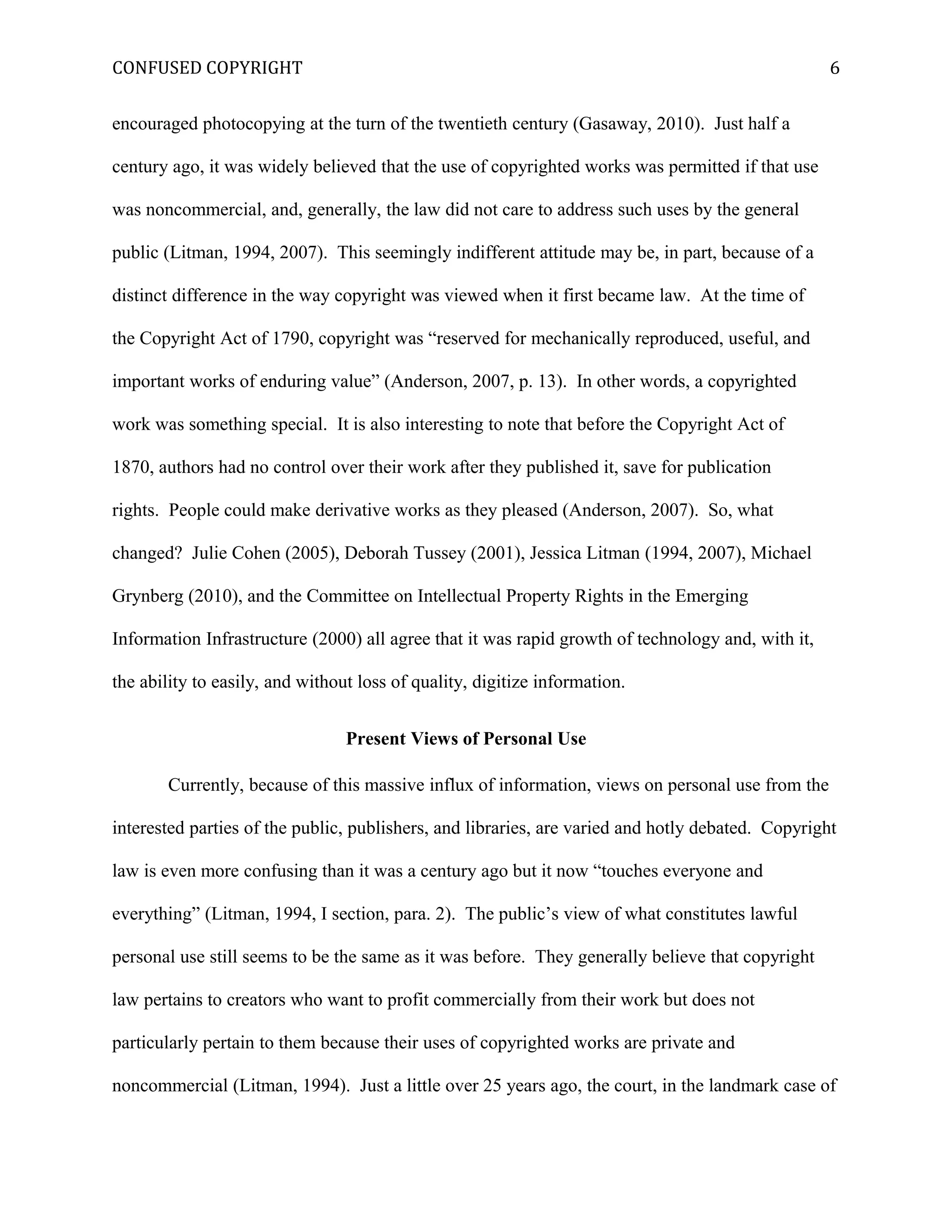
![CONFUSED COPYRIGHT
Sony Corp. of America v. Universal City Studios, Inc. ([Sony v. Universal], 1984), asserted
that noncommercial home use recording of material broadcast over the public airwaves
was a fair use of copyrighted works and did not constitute copyright infringement. It
emphasized the fact that the material was broadcast free to the public at large, the
noncommercial character of the use, and the private character of the activity conducted
entirely within the home.” (para. 12).
This could be seen as something of an acknowledgement of what the public already thought.
Although, some contend that this view of the courts has largely changed to instead favor
copyright holders, particularly since most copies now being made are digital, instead of analog as
they were when the case was decided (Litman, 2007). Although the views differ on the extent of
allowable personal copying, it is largely agreed upon by everyone, save a conflicting district
court opinion (UMG Recordings v. MP3, 2000), that personal uses that involve “time shifting”
(Sony v. Universal, 1984) and “space shifting” (Recording Industry Association of America v.
Diamond Multimedia Systems, Inc. [RIAA v. Diamond Multimedia], 1999) are permissible,
albeit grudgingly on the part of affected industries, as they appear to desire control over all
copies of their works. Concerning the copying of materials for personal use in libraries, some
libraries and library patrons continue to copy print materials without abandon, as they have done
for centuries. Fortunately, with The Copyright Act of 1976 and the addition of Section 108
(Limitations on Exclusive Rights: Reproductions by Libraries and Archives) to copyright law,
this practice has been addressed. Section 108 gives permission to libraries to make copies of
writings (such as journal articles and books) for users and for other libraries through inter-library
loan, as long as the library meets certain criteria. However, rights-holders are now expressing a
fear that, in the future, Section 108 will broaden to include digital files or licensed databases and
7](https://image.slidesharecdn.com/4e3fe4c4-7ca1-4501-a4e7-549c49c78607-160709192149/75/Copyright-Personal-Use-Paper-and-Annotated-Bibliography-7-2048.jpg)
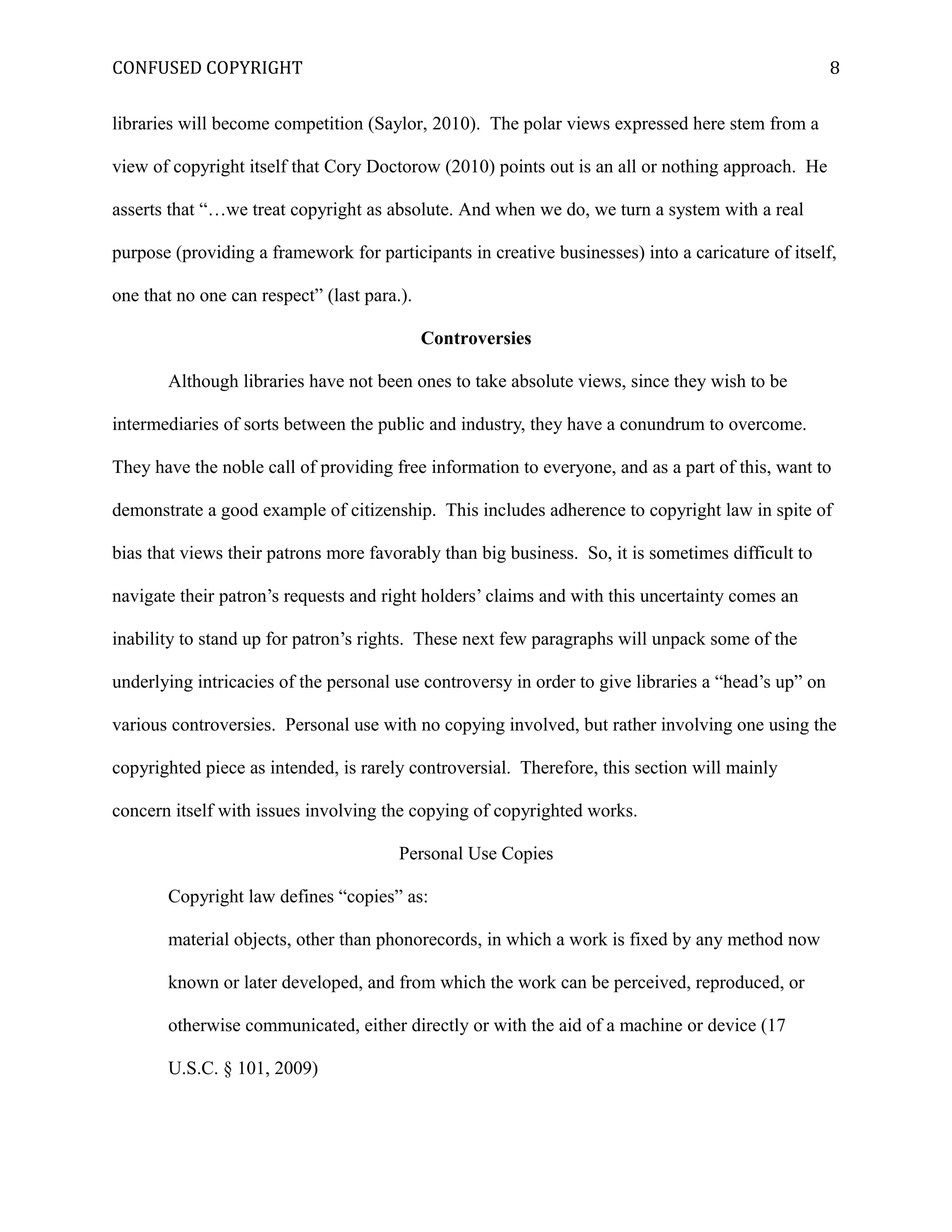
![CONFUSED COPYRIGHT
The Committee on Intellectual Property Rights in the Emerging Information Infrastructure ([The
Committee], 2000) has brought up a question of whether the term “copy” is still a good concept
in light of recent technological advances. Unlike copies of print materials, digital copies are
indistinguishable from the original. Hence, there is no natural end to redistribution and the
information contained within is more susceptible to unwanted change. This is a major concern
of rights holders and a reason for them to claim that all copying is unlawful. The Committee
does not attempt to resolve the personal use issue but does take the same stance as Doctorow
(2010) in stating that not all personal uses are fair use and not all copying is unlawful, while also
further maintaining that the notion that all noncommercial copying is fair use is far too
widespread.
Licenses
Copyright owners have sought to combat unfettered personal copying by supplying
licenses for those uses. Litman (2007) makes a note that companies have essentially redefined a
“commercial” use to mean an “unlicensed” use. The Committee (2000) tells how licensing
“constitutes a limited transfer of rights to use an item on stated terms and conditions” (p. 35).
Contract law, not copyright law, governs licenses and the problem comes when the terms of the
license end up being more restrictive than what is granted under the first-sale doctrine. This
leaves the public, and potentially libraries, without the provisions that copyright law provides to
remove undue burden on the user of copyrighted works (The Committee, 2000). This issue
almost literally bombed the library community only two months ago. The publisher
HarperCollins announced that the license on their eBooks sold to libraries would expire after
twenty-six checkouts. In other words, libraries will need to repurchase an eBook every time the
limit is reached on that book. Two other publishers, Macmillan and Simon & Schuster, do not
9](https://image.slidesharecdn.com/4e3fe4c4-7ca1-4501-a4e7-549c49c78607-160709192149/75/Copyright-Personal-Use-Paper-and-Annotated-Bibliography-9-2048.jpg)

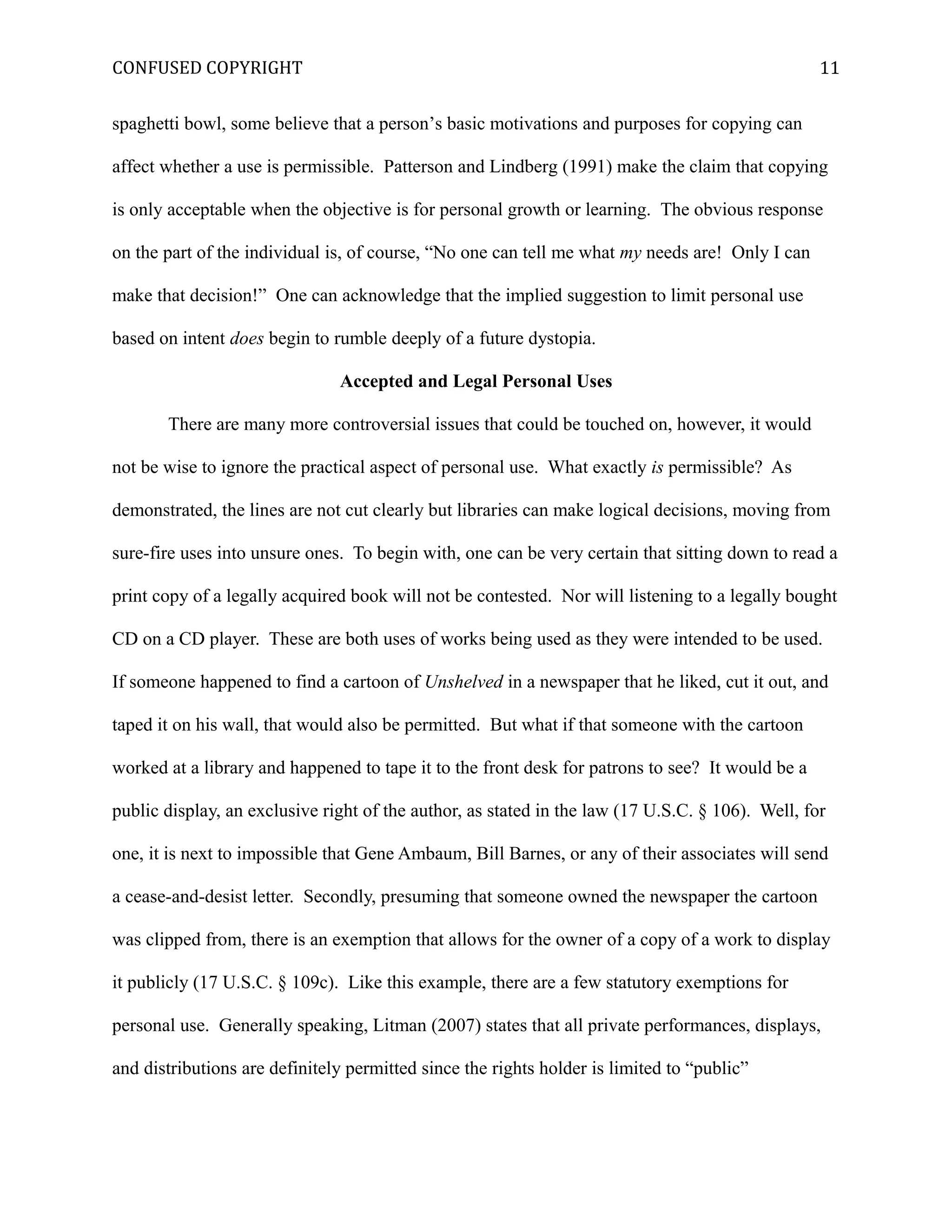
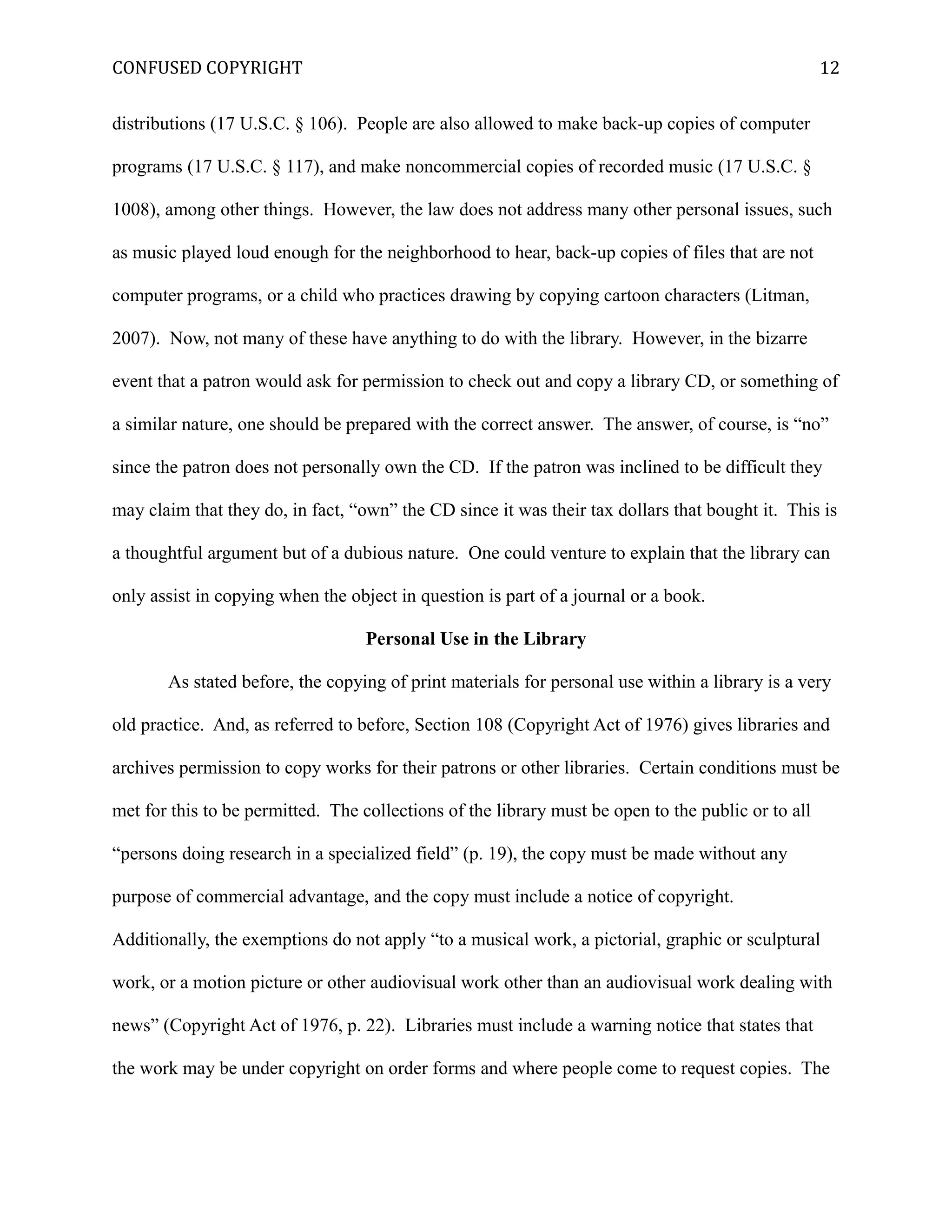

![CONFUSED COPYRIGHT
offered to them for electronic databases and journals and found that over ninety percent of them
“undermined the exemptions in the law that relate to core library activities” (Brindley, 2009, p.
6). He proposes that the relatively simple permissions given in copyright law have the ability to
“trump” such contracts since they interfere with libraries being able to copy items for patrons,
among other things. Litman (1994) makes a proclamation that the U.S. Copyright Office needs
to become the general public's copyright lawyer “…to persuade all of us…that the public's
interests are compatible rather than adverse to the interests of copyright owners, but also to make
it so…The Copyright Office…has failed to attend to the danger that the bargain [of copyright
law] might unbalance to the detriment of the public. All it would take would be for the Office to
view the public as its copyright client.” (section VI, last para.). It may well be up to libraries to
be the ones to encourage this and to fight for the rights of public, certainly no one else
understands the need for accessible information as well as them. The personal use debate needs
the opinions of librarians, the ones who interact practically with copyright every day, concerning
the definition, the interpretations of history, the controversies, the current practices, and the
future of personal use. Then, the world may forestall the doom of a utopia without creativity,
however over-dramatized.
14](https://image.slidesharecdn.com/4e3fe4c4-7ca1-4501-a4e7-549c49c78607-160709192149/75/Copyright-Personal-Use-Paper-and-Annotated-Bibliography-14-2048.jpg)
![CONFUSED COPYRIGHT
References
Anderson, E. (2007, December). Pimps and ferrets: Copyright and culture in the United States,
1831-1891 (Doctoral dissertation, Bowling Green State University). Retrieved from
http://etd.ohiolink.edu/send-pdf.cgi/Anderson%20Eric.pdf?acc_num=bgsu1193529137
Brindley, D. (2009). Phoenixes in the internet era: the changing role of libraries. Paper
presented at the 2009 Association Littéraire et Artistique Internationale (ALAI) Congress
in London, England. Retrieved from http://www.alai2009.org/programme.aspx
Cohen, J. E. (2005). The place of the user in copyright law. Fordham Law Review, 74, pp. 347-
374. Retrieved from http://papers.ssrn.com/sol3/papers.cfm?abstract_id=814664
Committee on Intellectual Property Rights in the Emerging Information Infrastructure (2000).
The digital dilemma: Intellectual property in the information age. Retrieved from The
National Academies Press website: http://www.nap.edu/ openbook.php?
record_id=9601&page=R1
Copyright Act of 1976, 17 U.S.C. § 108 (2009). Retrieved from http://www.copyright.gov/
title17/92chap1.pdf
Doctorow, C. (2010, January 26). Copyright, companies, individuals and news: the rules of the
road. The Guardian. Retrieved from http://www.guardian.co.uk/technology/2010/jan/26/
copyright-cory-doctorow
Gasaway, L. N. (2010). Libraries and copyright at the dawn of the twentieth century: The 1909
Copyright Act. North Carolina Journal of Law & Technology, 11(3). Retrieved from
http://www.ncjolt.org/sites/default/files/Gasaway_Laura_v11i3_419_460.pdf
Geist, M. (2005, August 8). The failure of Canada’s private copying system [blog post]. Michael
Geist. Retrieved from http://www.michaelgeist.ca/index.php?option=content&task=
15](https://image.slidesharecdn.com/4e3fe4c4-7ca1-4501-a4e7-549c49c78607-160709192149/75/Copyright-Personal-Use-Paper-and-Annotated-Bibliography-15-2048.jpg)
![CONFUSED COPYRIGHT
view&id=924
Grynberg, M. (2010). Property is a two-way street: Personal copyright use and implied
authorization. Fordham Law Review, 79(2). Retrieved from http://papers.ssrn.com/sol3/
papers.cfm?abstract_id=1729411
Hadro, J. (2011, February 25). HarperCollins puts 26 loan cap on Ebook circulations.
LibraryJournal.com. Retrieved from http://www.libraryjournal.com/lj/home/889452-
264/harpercollins_puts_26_loan_cap.html.csp
Hirtle, P. B., Hudson, E. & Kenyon, A. T. (2009). Copyright & cultural institutions: Guidelines
for digitization for U.S. libraries, archives, & museums. Ithaca, NY: Cornell University
Library. Electronic copy available at: http://ssrn.com/abstract=1495365
Jordan, R. (2000). Permissions and copyright. Lutheran-Hymnal.com. Retrieved from
http://www.lutheran-hymnal.com/index.html
Kennedy, D. M. (2005, June 6). iPods and time-shifting: Fair use, personal use and the digital
copyright morass. Between Lawyers. Retrieved from http://betweenlawyers.corante.com/
archives/2005/06/06/ipods_and_timeshifting_fair_use_personal_use_and_the_digital_co
pyright_morass.php
Litman, J. (1994). The exclusive right to read. Cardozo Arts & Entertainment Law Journal,
13(29). Retrieved from http://www-personal.umich.edu/~jdlitman/papers/read.htm
Litman, J. (2007, June). Lawful personal use. Texas Kaw Review, 85. Retrieved from
http://www-personal.umich.edu/~jdlitman/papers/LawfulPersonalUse.pdf
Patry, W. (2006, November 30). Fair use and personal copying exemptions [Blog post]. The
Patry Copyright Blog. Retrieved from http://williampatry.blogspot.com/2006/11/fair-
use-and-personal-copying.html
16](https://image.slidesharecdn.com/4e3fe4c4-7ca1-4501-a4e7-549c49c78607-160709192149/75/Copyright-Personal-Use-Paper-and-Annotated-Bibliography-16-2048.jpg)
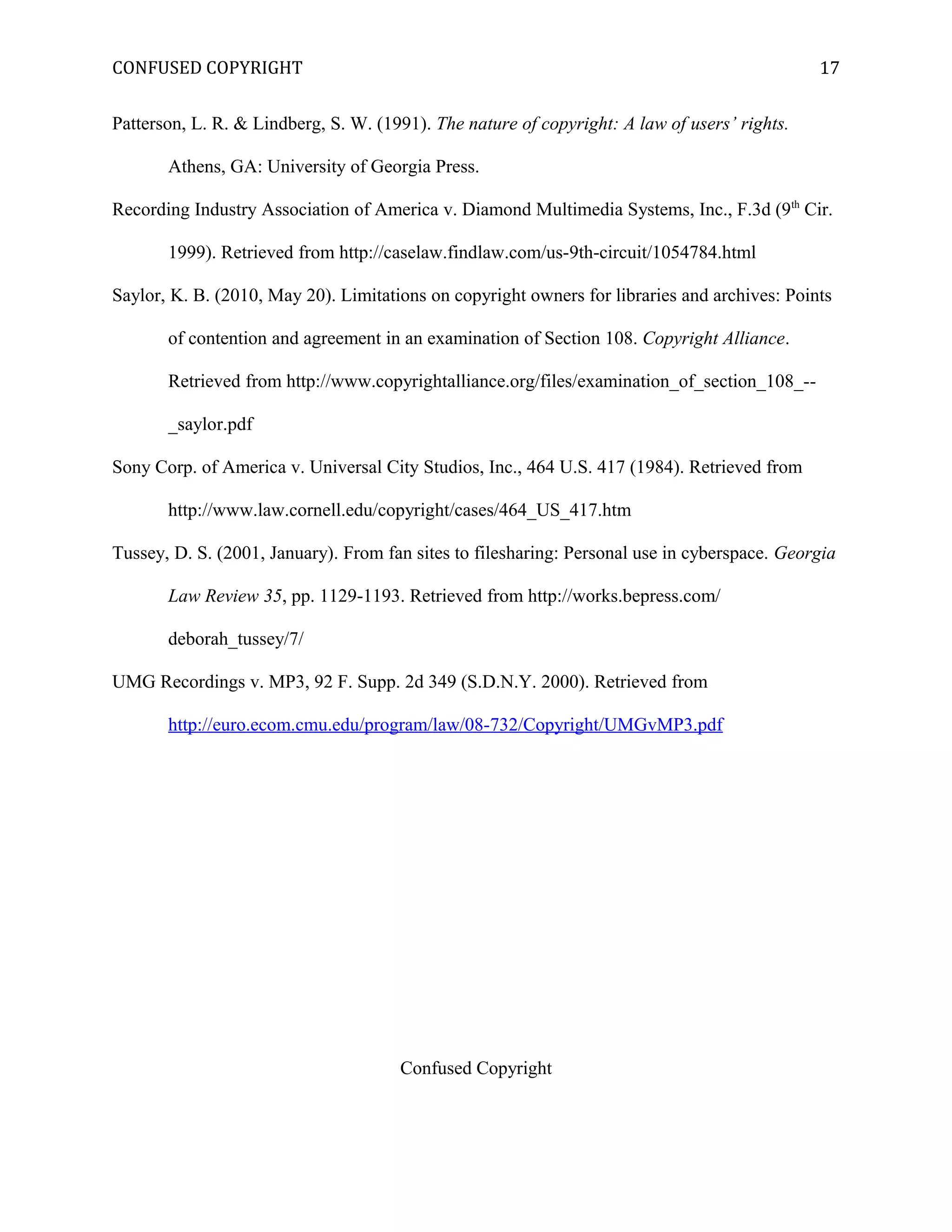
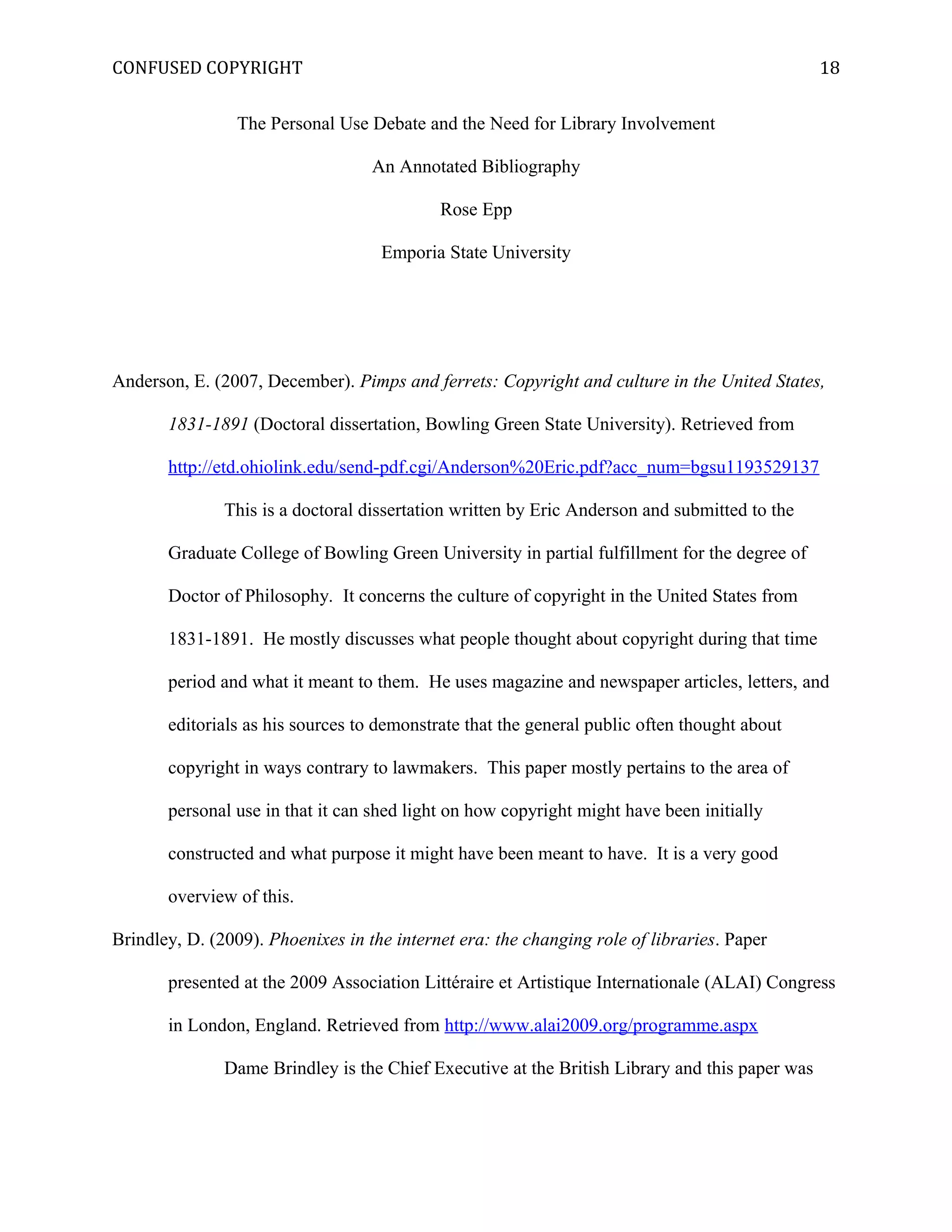
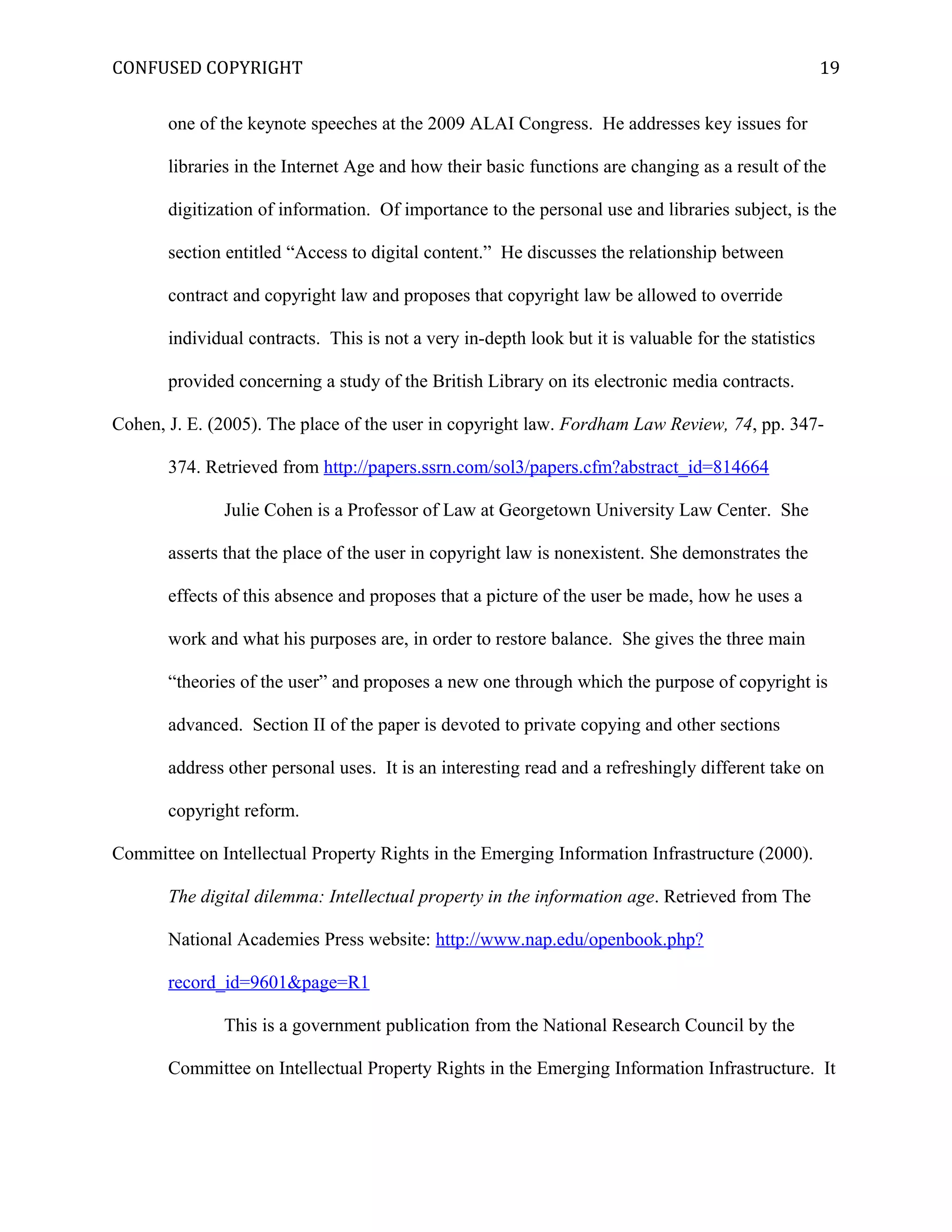
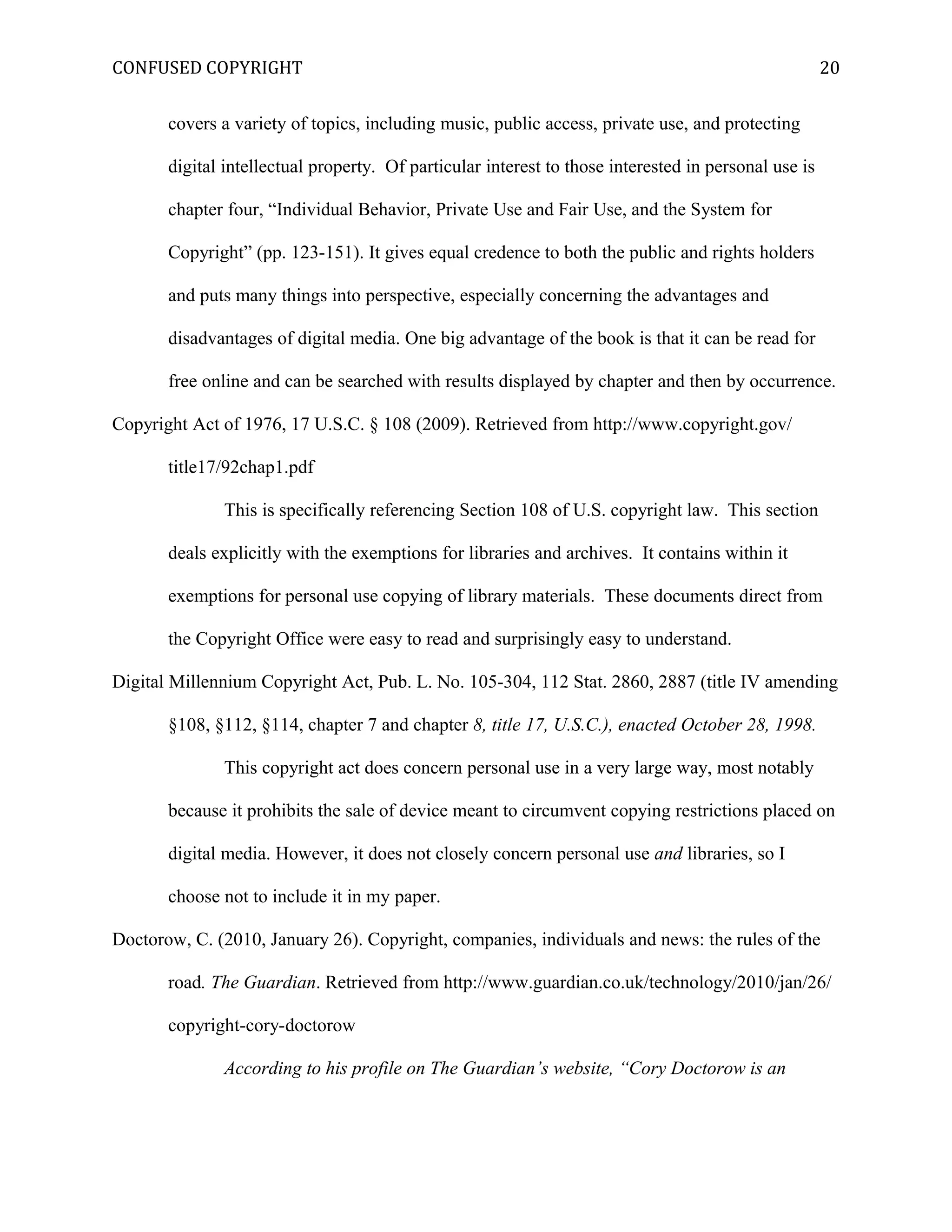
![CONFUSED COPYRIGHT
activist, science fiction author and co-editor of the blog Boing Boing.” His profile also
lists several articles that he has written that concern copyright. This short article
discusses how people do and should view copyright. He claims that most view it as a law
of absolutes when nothing could be farther from the truth. This is a good thought-
provoking article on what should be considered a personal use and what should not be.
Gasaway, L. N. (2010). Libraries and copyright at the dawn of the twentieth century: The 1909
Copyright Act. North Carolina Journal of Law & Technology, 11(3). Retrieved from
http://www.ncjolt.org/sites/default/files/Gasaway_Laura_v11i3_419_460.pdf
Laura Gasaway is the Associate Dean for Academic Affairs & Professor of Law
at the School of Law, University of North Carolina-Chapel Hill. Obviously, her paper
mainly concerns the 1909 Copyright Act. It is very thorough in its discussion of this.
This source was important for this paper because it reported on the copying activities of
libraries and their users in times past (pp. 425-427 and section IV).
Geist, M. (2005, August 8). The failure of Canada’s private copying system [blog post]. Michael
Geist. Retrieved from http://www.michaelgeist.ca/index.php?option=content&task=
view&id=924
According to his website, “Dr. Michael Geist is a law professor at the University
of Ottawa where he holds the Canada Research Chair in Internet and E-commerce Law.”
This short article discusses the effect of the levy placed on recording media in Canada in
order to allow for personal copying of music. Since it concerns Canada, not the United
States, it only afforded a brief mention in my paper. It is valuable in that it effectively
demonstrates that the grass is not greener where there is civil law for personal use, as
some in this country are inclined to believe.
21](https://image.slidesharecdn.com/4e3fe4c4-7ca1-4501-a4e7-549c49c78607-160709192149/75/Copyright-Personal-Use-Paper-and-Annotated-Bibliography-21-2048.jpg)

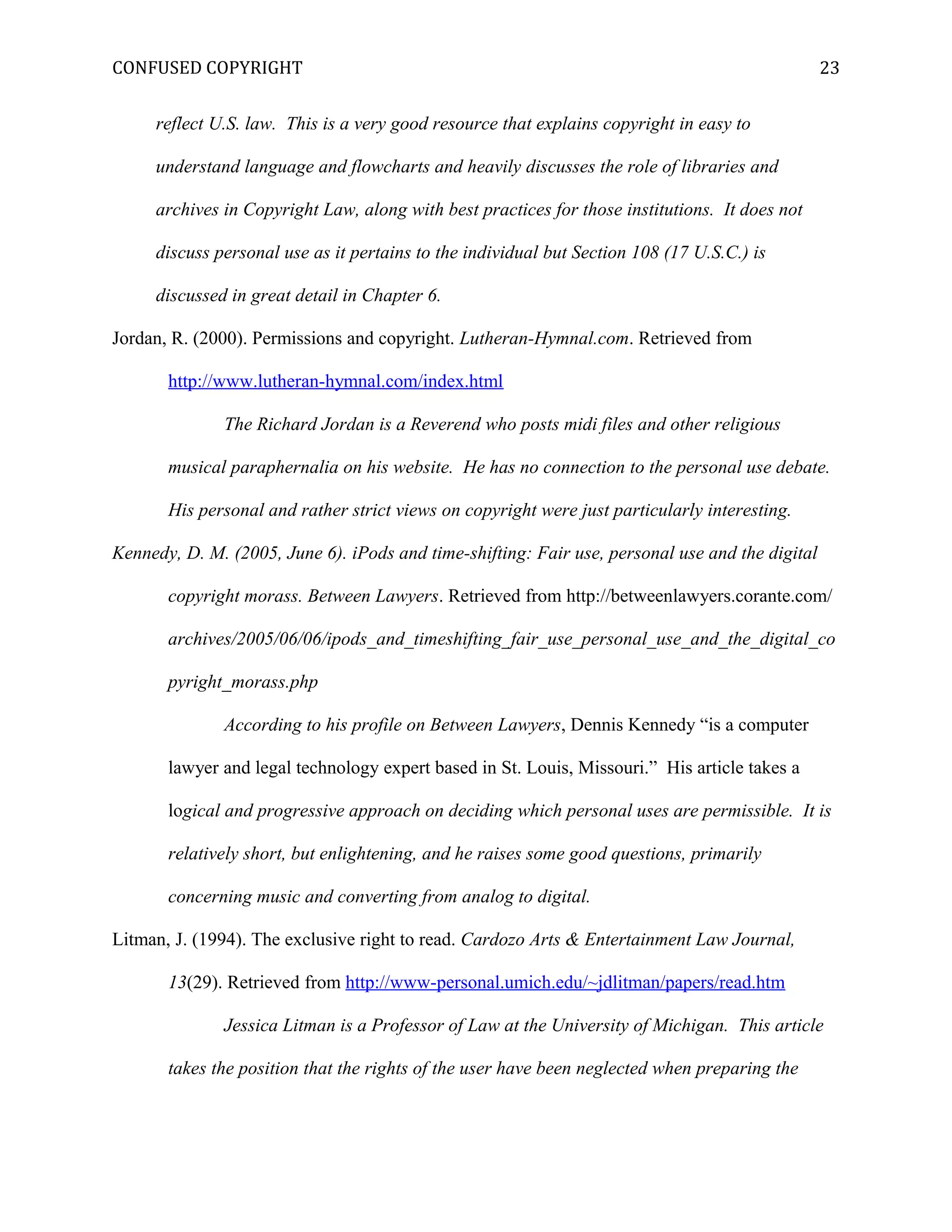
![CONFUSED COPYRIGHT
“bargain” of copyright law between the user and industry. She advocates for the
Copyright Office to be the public’s copyright lawyer and for a copyright law to be
drafted that even school children can understand. She uses many, many sources and it is
an enjoyable read since it is written in a largely casual style.
Litman, J. (2007, June). Lawful personal use. Texas Kaw Review, 85. Retrieved from
http://www-personal.umich.edu/~jdlitman/papers/LawfulPersonalUse.pdf
Also by Jessica Litman, this article uses so many sources and footnotes that they
probably take up more space than the article itself. In it, Litman discusses just what the
title says, “lawful personal use.” Her topics are: copyright as it relates to the enjoyment
of copyrighted works, court cases that are “stingy” with copyright holders’ rights, a
definition of personal use, personal uses that are noncontroversial, an analysis of
copyright owners’ rights, and a look at the idea that all nonlicensed uses are infringing
unless excused in the law. This article is a real wealth of information and one that I
referred to often.
Patry, W. (2006, November 30). Fair use and personal copying exemptions [Blog post]. The
Patry Copyright Blog. Retrieved from http://williampatry.blogspot.com/2006/11/fair-use-
and-personal-copying.html
William Patry is a copyright lawyer and this article is from his personal blog. It
is mainly a something of a rant about the Wal-Mart and Warner Brothers deal that
requires one to purchase separate copies of a movie for one’s computer and iPod but
there are some good thoughts contained within concerning personal use and civil law.
Patterson, L. R. & Lindberg, S. W. (1991). The nature of copyright: A law of users’ rights.
Athens, GA: University of Georgia Press.
24](https://image.slidesharecdn.com/4e3fe4c4-7ca1-4501-a4e7-549c49c78607-160709192149/75/Copyright-Personal-Use-Paper-and-Annotated-Bibliography-24-2048.jpg)
